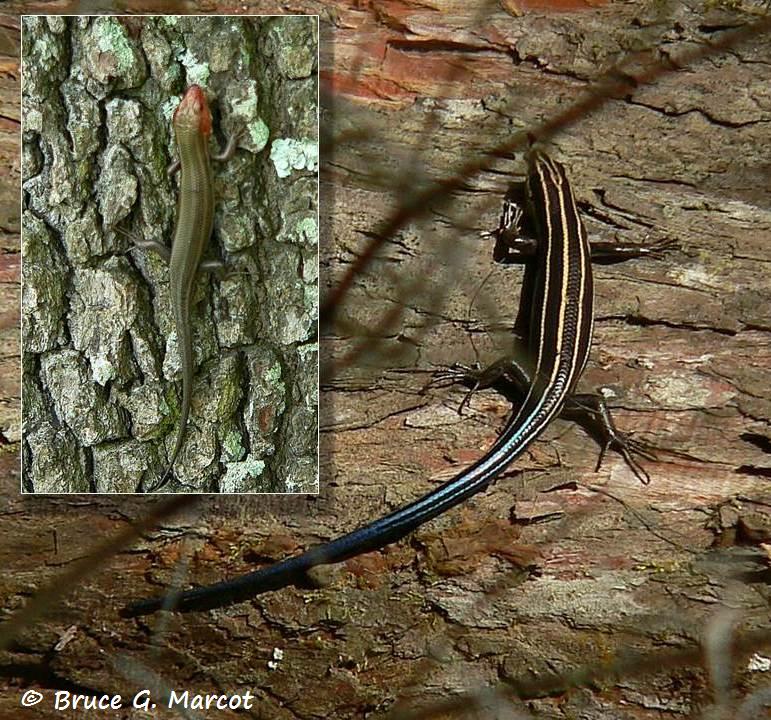
|
|
Questions for the Skink |
|
|
Click on images for larger versions

|
|
Questions for the Skink |
|
Five-lined Skink (Eumeces
fasciatus), Family Scincidae |
Credit & Copyright: Dr. Bruce G. Marcot
Explanation: These two beautiful reptiles are one and the same ... the same species, that is, but different age classes. The blue-tailed form on the right is a juvenile, which may eventually transform into the red-headed adult male on the left. (Click on either one to view its full photo.)
These are "five-lined skinks," the name of which probably needs little explanation.
We are in the wonderful Jean Lafitte National Historic Park and Preserve in very southern Louisiana along the Gulf of Mexico. We previously visited this site and puzzled over another reptile found there. This time, it's the skink's turn.
Five-lined skinks are widely distributed in eastern North America and usually inhabit moist woody areas. Although many sources nicely describe the striking patterns in both juvenile and adult forms, none has explained exactly how this color difference exists and has evolved.
Is there some adaptive advantage for juveniles to be so strikingly patterned? Does the combination of the blue tail and white stripes serve to break up the body outline against the twigs and leaves of the forest floor, and thus help the skink escape predation? Skinks can drop their tails if grasped by a predator, so the blue color probably attracts predators to the disposable tail instead of the head or body.
But then why don't adults retain this advantage of color?
Why does the adult form, which is about the same size, lose such patterns? Does the red head of the male serve as a sexual symbol or territory marker, as is found in analog lizard species of a totally different family, the agamids of the Old World (family Agamidae)?
One study (Olsson et al. 2013) of color in reptiles suggests that lizards that show strikingly different patterns and colors within the same species are good subjects for studying evolution. Another study (De Lanuza et al. 2013) asserts that sexual selection drives the development of bright colors in whiptail lizards. Yet another study (Chapple et al. 2008) explored how loss of color differences in skinks of Australia may have been affected by attributes of their habitats, particularly climate and elevation.
The main question is, if there is great adaptive advantage to the color patterns of both juvenile and male, and to their transformation, then why haven't all other lizard species and families -- other than the agamids -- evolved this, as well?
Natural history revels in description, but it becomes a true science only when it can not only describe and explain, but also predict. In the case of the five-lined skink, these questions remain ...
Information:
Chapple, D.G., M.N. Hutchinson, B. Maryan, M. Plivelich, J.A. Moore, and J. S. Keogh. 2008. Evolution and maintenance of colour pattern polymorphism in Liopholis (Squamata: Scincidae). Australian Journal of Zoology 56:103-115.
De Lanuza, G. P., E. Font, and J. L. Monterde. 2013. Using visual modelling to study the evolution of lizard coloration: sexual selection drives the evolution of sexual dichromatism in lacertids. Journal of Evolutionary Biology 26:1826-1835.
Olsson, M., D. Stuart-Fox, and C. Ballen. 2013. Genetics and evolution of colour patterns in reptiles. Seminars in Cell & Developmental Biology 24(6-7):529-541.
Next week's picture:
Flighted and Flightless
< Previous ... | Archive |
Index |
Location | Search | About EPOW | ... Next >
|
|
Author & Webmaster: Dr.
Bruce G. Marcot
Disclaimers and Legal
Statements
Original material on Ecology Picture of the Week ©
Bruce G. Marcot
Member Theme of The Plexus